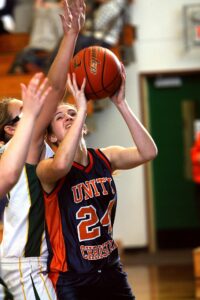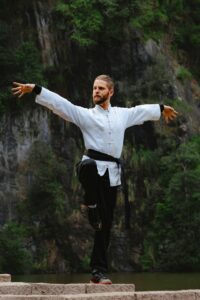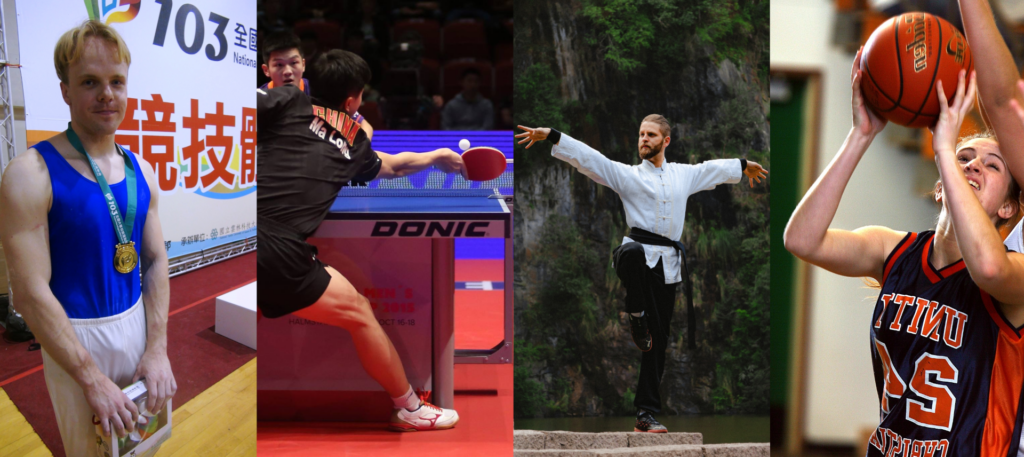Throughout my journey to learn Chinese, I’ve used sports to boost my learning. I’ve played badminton, football and volleyball with native speakers, practised gymnastics and diving entirely in Chinese, and even taken one semester of Physical Education at university in Taiwan. While the general benefits of physical activity are well-known, I think the more specific benefits for learning languages are less widely known, so let’s look at 6 benefits of learning Chinese through sports!
Tune in to the Hacking Chinese Podcast to listen to the related episode:
Available on Apple Podcasts, Google Podcasts, Overcast, Spotify, YouTube and many other platforms!
Physical activity boosts learning, it doesn’t detract from it!
Sports, and physical activities in general, are sometimes viewed as opposed to academic success. You’re either good at sports or academic subjects, but not both, and if you focus on one, you’ll fall behind with the other.
If you must excel in an important examination, such as the Chinese university entrance exam (高考, gāokǎo), practising sports is a waste of time and effort that should have gone into studying instead, a view not uncommon among Chinese parents.
 In most cases, this is a false dichotomy, however, because sports and physical activity have clear benefits for learning other subjects, including Chinese. These range from general benefits for health, cognition and motivation, to more specific opportunities to learn Chinese language and culture embedded in a meaningful and social context. Practising sports can also help you make friends and widen your social sphere.
In most cases, this is a false dichotomy, however, because sports and physical activity have clear benefits for learning other subjects, including Chinese. These range from general benefits for health, cognition and motivation, to more specific opportunities to learn Chinese language and culture embedded in a meaningful and social context. Practising sports can also help you make friends and widen your social sphere.
Naturally, some benefits will only be accessible if you live in a Chinese-speaking environment or if you’re able to find Chinese people to play or practise with where you live. Other benefits are relevant no matter where you live.
6 benefits of learning Chinese through sports
Let’s have a look at how physical activity can boost your Chinese learning:
- Long-term benefits on physical and mental health – There are many benefits associated with physical activity I won’t dwell on them here because you’ve all heard them before. It’s worth noting that research shows that physical activity has a positive impact on cognitive functions, even though the influence on academic achievement as such is complex (see Donnelly et al, 2016). One area of particular interest is the ability to concentrate, which is crucial for learning languages and is boosted by physical activity as well.
- Learning languages while moving – There is also research to suggest that we learn better while moving, such as memorising vocabulary while on a treadmill (Schmidt-Kassow et al., 2014). I’ve heard several explanations for why this might be the case, including one from evolutionary biology pointing out that moving triggers the brain to think that something important is going on. While we think our computers are terribly interesting, our brains evolved in an environment where new things often appeared when moving around.
- Comprehensible and embedded communication – It’s abundantly clear that meaningful input is essential for learning a new language. When practising sports or doing other physical activities, the language used is embedded in a meaningful context. You can see and hear what’s going on, scaffolding your understanding of the language. Physical activities, especially team sports, also generate opportunities for real communication, where you speak to convey an important and sometimes urgent message. This is also one of the best things with learning through games in general, and sports is of course a subset of games.
- Fun, interesting and motivating – If you find the right sport, or if you can practise a sport you love in Chinese, this can be great fun and provide strong motivation to learn more. Personally, I’ve been incredibly lucky in this domain, as I was able to practise gymnastics for at least a dozen hours a week throughout my two years in graduate school in Taiwan. Don’t forget, having fun is not just feel-good advice, it’s really important!
- Making friends and expanding social life – This has the potential to be the most important benefit of practising sports in Chinese. If you’re mostly an introverted student like me, you’re not going to make many Chinese friends simply by going about your daily life. You need a reason to hang out with people, especially if you want to get to know people who are not teachers or avid language learners themselves. A shared sport is the perfect opportunity! As you get to know people better, the benefits will multiply as you get to know their friends and start hanging out even when you’re not practising. While this is easier for team sports, it works for individual sports too (more about this later).
 Culturally significant sports and physical activities – Let’s not forget that you can learn much about Chinese language and culture by focusing on activities that have a cultural significance in the Chinese-speaking world. In my case, I started practising Tai Chi, which eventually lead me to learning Chinese as well. The activity does not have to be tied to Chinese philosophy or have a long history, so playing table tennis or joining in the local Chinese square dancing (广场舞, guǎngchǎngwǔ) work too.
Culturally significant sports and physical activities – Let’s not forget that you can learn much about Chinese language and culture by focusing on activities that have a cultural significance in the Chinese-speaking world. In my case, I started practising Tai Chi, which eventually lead me to learning Chinese as well. The activity does not have to be tied to Chinese philosophy or have a long history, so playing table tennis or joining in the local Chinese square dancing (广场舞, guǎngchǎngwǔ) work too.
These are the main benefits for learning Chinese through sports, but there’s more to say about all of them. Here I will focus on three things: the social aspects of practising sports in Chinese, a teaching method called Total Physical Response (TPR) and how to implement physical activities in your learning or teaching routine.
Sports help you make friends and learn Chinese
The more you engage with the Chinese language, the more you learn. You should take any opportunity you can to fill your life with Chinese, which includes converting aspects of your life into Chinese.
This is true for your social life, too. Integrative motivation, referring to the desire to fit in and be understood in a social context, can be powerful. This could be with a partner or a loved one, but it could be with friends, classmates or colleagues.
Or with people who play or practise sports with you.
As mentioned earlier, this is not limited to team sports. If I say that I learnt Chinese by playing basketball, I think few people would be surprised; you do need to communicate with teammates during a game.
If I were to say that my Mandarin improved because I joined the university swimming team, this would be met with frowns.
I competed in swimming for almost ten years, so I’m familiar with the sport. You spend most of your time with your ears below water, so barring bone conduction earphones that most people have never heard of, you’re not going to learn any Chinese while crawling.
But that’s not the point. The point is that most interaction with other people takes place outside of the swimming pool, basketball court or gymnastics gym anyway.
Sure, people communicate when playing basketball, but this communication is extremely limited compared to ordinary social interactions.
 Hence, most of the language input and interaction you’ll get through sports takes places when you’re not actually performing the sport, so it doesn’t matter if it’s swimming or basketball.
Hence, most of the language input and interaction you’ll get through sports takes places when you’re not actually performing the sport, so it doesn’t matter if it’s swimming or basketball.
When I practised gymnastics in graduate school in Taiwan, I talked with the other people on the team before we practised, when we rested during practise, and then for an hour or more after practice when we usually had dinner together. There are few better environments to learn Chinese!
Learning Chinese through Total Physical Response
Even though the social aspect is the most important one, there are reasons to believe that physical activity can aid language learning more directly. As mentioned earlier, language usage in sports is embedded in a meaningful context, usually with clear references to objects and motion.
But you don’t need sports to achieve this, it can be done with basic movements and even works in a normal classroom. The best-known teaching method relying on this principle is Total Physical Response (TPR), developed by James Asher.
In this method, the teacher models physical actions and links them to spoken language. For example, the teacher might say “stand up” while performing that motion, then says “sit” and then sit down. The teacher then issues these commands to the students, who follow the instructions. Later, the students can take over and give the teacher or each other instructions.
TPR works well for adults too
This seems limited at first, but you can cover a wide range of language this way. For example, you can include if-clauses in your instructions and say something like “if you wear red raise your left hand, if you wear green raise your right hand”.
Instructions from a sports coach can be viewed as a form of TPR. The coach notices something you’re not doing right and instructs you in Chinese how to perform the motion correctly.
You do your best to improve and receive more feedback. Communication is mediated both through verbal instructions in Chinese and more direct forms of modelling such as showing the correct motion or pointing to the problem.
I should point out that even if TPR is often associated with younger learners, it works well with adults too. I’ve used the method to teach beginner students at university many times.
For example, to practise basic directions and movements, I once told some students to leave the classroom, then built a simple maze using desks and chairs with the help of the remaining students. Then I called in the students who had been waiting outside and one by one, blindfolded, and let the students who had built the maze guide their blindfolded classmates through it by issuing instructions in Chinese.
This was great fun and they all got to practise the vocabulary they had learnt in a meaningful context. It was also a chance for everybody to move around a bit and mix things up before we continued with the rest of the lesson. There’s a limit to how long you can sit still to study; everybody needs regular breaks.
Physical activities for a rich and varied learning environment
As I often talk about on Hacking Chinese, to learn as much as possible, you need to find ways of diversifying your learning. The clearest parallel here is to listening ability, where it’s important that you have listening material available at different levels. If you’re full of energy and want to tackle something interesting but hard, do so, but if you don’t feel up to it, choose something easier, and if you’re tired, just put on some Chinese music in the background.
The idea here is not that listening to Chinese music in the background is better than fully concentrating on a podcast, but that doing something is always better than nothing.
Similarly, I’m not saying that you should drop all other forms of learning and only rely on sports, but if you want to spend lots of time learning Chinese, you must vary the ways in which you learn. Mixing things up with physical activities has benefits on many levels!
Conclusion
Physical activities and sports have so many benefits for learning Chinese and beyond that it would be unwise to ignore them.
If you are a student, explore ways you can make sue of the benefits I’ve discussed in this article. If this is not possible to join a club with mostly native speakers (this would be hard if you aren’t living abroad, for instance), you can still make sure to incorporate physical activity and exercise in your learning routine. Listen to podcasts while you walk, make a point of not sitting for too long when reading, and so on.
If you’re a teacher, check out TPR and see if you can include elements from it in your teaching. As I showed above, this needn’t be complicated and is, at least in my experience, appreciated by young and old students alike.
For a more carefully argued rationale and supporting research for physical activities in the classroom, I strongly suggest the article “Playing to learn: A review of physical games in second language acquisition” by Tomlinson and Masuhara (2009).
References and further reading
Asher, J. J. (1969). The total physical response approach to second language learning. The modern language journal, 53(1), 3-17.
Donnelly, J. E., Hillman, C. H., Castelli, D., Etnier, J. L., Lee, S., Tomporowski, P., … & Szabo-Reed, A. N. (2016). Physical activity, fitness, cognitive function, and academic achievement in children: a systematic review. Medicine and science in sports and exercise, 48(6), 1197.
Schmidt-Kassow, M., Deusser, M., Thiel, C., Otterbein, S., Montag, C., Reuter, M., … & Kaiser, J. (2013). Physical exercise during encoding improves vocabulary learning in young female adults: a neuroendocrinological study. PloS one, 8(5), e64172.
Schmidt-Kassow, M., Zink, N., Mock, J., Thiel, C., Vogt, L., Abel, C., & Kaiser, J. (2014). Treadmill walking during vocabulary encoding improves verbal long-term memory. Behavioral and Brain Functions, 10, 1-9.
Tomlinson, B., & Masuhara, H. (2009). Playing to learn: A review of physical games in second language acquisition. Simulation & Gaming, 40(5), 645-668.


12 comments
I had been thinking about doing this myself. Unfortunately, I don’t live near a university, and the only sports which can be done in this area are walking, biking, and hiking, none of which are particularly social.
Fortunately, I am the kind of person who can strike up conversations with strangers in the park 😉
Great tip! You created a learning environment for yourself and it was a fun one. I always take the kids to the playground when we visit Taiwan. They play and they speak Chinese to new friends.
I also think so. It´s a very good idea.
Very good advice, thank you 🙂
I’m thinking of going to China in the near future (before or during summer 2013 if possible), and it’ll probably be outside of university context. I mean I’ll have 100% free time, but less opportunities at first to get in contact with people.
Joining a sports club is therefore an excellent suggestion 🙂
I have some questions :
(1) which sports would you consider more ‘social’? i.e. you can talk a little during the training, OR feel some kind of proximity with other people (because talking during training isn’t always good ;)), which will lead to discussion after training, to taking a drink and other activities outside of the club (in short, make friends from this). I’m thinking team sports… do they practice baseball in China, or is it just Japan and the USA in the whole world? 😛 Any other ideas?
(2) what kind of other clubs (i.e. not sports) could you join easily, as before with the objective of socializing? Board games look nice, you can easily talk and take your time 🙂 (I’d be interested in Go)
(3) can you easily join the above kind of clubs, at any moment of the year and only for the duration of your (short) stay? where do you have to inquiry to join a club at a random time?
Actually I’m thinking I’d like you to write an article basically explaining how to socialize in China if you go there with this sole purpose (no job, studies, whatever, completely vacations-like). With tons of good examples like this, and explaining what could work better or won’t be judged in a bad way specifically in China (thinking of cultural differences here, coz’ I really don’t know a lot about this for now).
Ideally I’d love some kind of program where you are hosted in a Chinese family, because that was my best time in Japan and also how I did tremendous progress (willing to pay for this). Well there’s WOOFing, but I’d like to avoid working and have my free time.
I wrote a really long answer and then accidentally hit “cancel” which deleted the entire comment. I’ll rewrite the important bits, but rewriting everything is too tedious. Sorry.
Basically, the answer to your questions depends on where you live, who you are and what you want. It’s very hard to give general answers. I’ll try, anyway.
1) I don’t think it matters much. Check what’s available, try them out and compare.
2) This depends entirely on where you are. I suggest asking a native speaker to help you look.
3) I have never had problems with this, but again, it might depend on where you are.
The reason I don’t write about this more is that there would have to be “it depends” disclaimers for every single sentence. 🙂
Good luck!
An important thing that I feel is worth mentioning to which I only saw one minor reference (bias: I worked in a neuroengineering lab) is that physical exercise is one of the best ways to stimulate brain activity. My best semester in college was the one where I exercised the most, even though I also had tons of work, so that “don’t have time” is an empty excuse, as you said. While in mainland China, I ran often which wasn’t particularly social, though I could talk while stretching and cooling down after a workout. Even in a totally isolated sport, that is a great time to listen to audio, review things in your head, or just decompress so that the rest of the day can be effective.